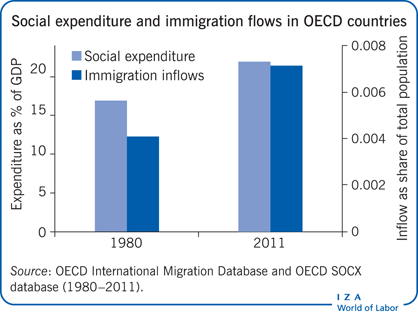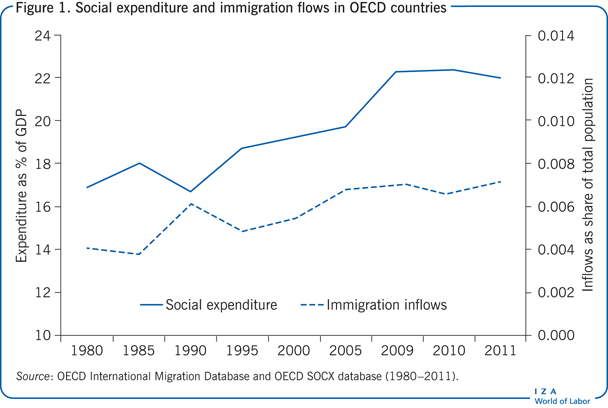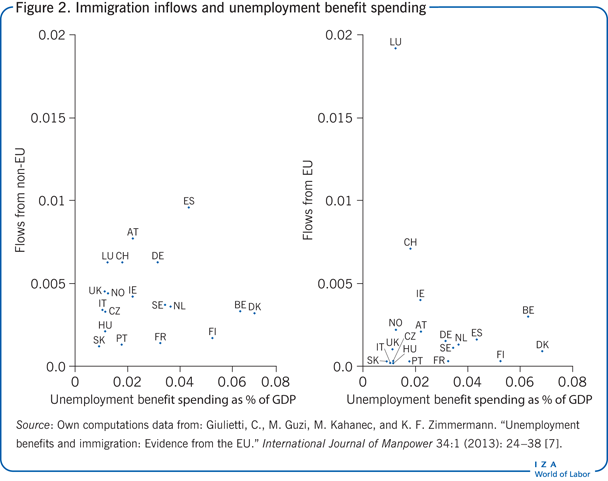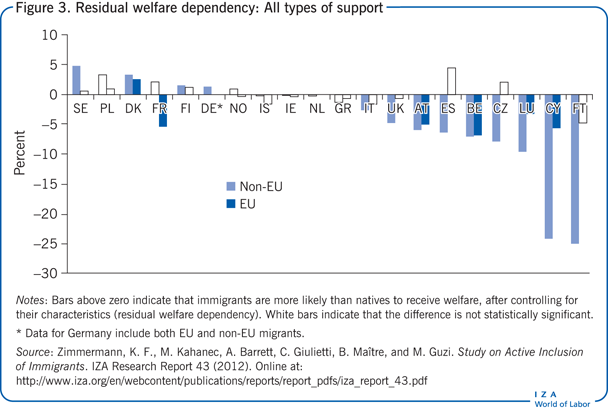Elevator pitch
Contrary to the welfare magnet hypothesis, empirical evidence suggests that immigration decisions are not made on the basis of the relative generosity of the receiving nation’s social benefits. Even when immigrants are found to use welfare more intensively than natives, the gap is mostly attributable to differences in social and demographic characteristics between immigrants and non-immigrants rather than to immigration status per se. Moreover, evidence in some countries suggests that immigrants exhibit less welfare dependency than natives, despite facing a higher risk of poverty.

Key findings
Pros
There is no strong support for the welfare magnet hypothesis.
Immigration is primarily driven by differentials in unemployment and wages between the sending and destination countries, by the presence of social networks, and by geographical proximity.
When immigrants are found to use welfare more intensively than natives, the gap is mostly attributable to differences in the social and demographic characteristics between the two groups.
Active welfare policy can reduce duration of social assistance use by immigrants
Cons
Eligibility constraints, linguistic deficiencies, cultural and social norms, and discrimination often limit immigrants’ welfare access.
Immigrants face a higher risk of poverty than natives, which is often not adequately compensated by welfare benefits.
When existing, welfare dependency decreases with the time spent in the host country, but at a slow rate.
Author's main message
Arguments that generous social welfare programs prompt immigration and that immigrants are more likely to use and abuse social programs are unfounded. On the contrary, immigrants often face a higher risk of poverty than natives, which is not adequately compensated by welfare programs. In fact, policies that restrict immigrants’ access to welfare benefits are likely to worsen their socio-economic integration and ultimately could lead to an increase in welfare claims. Thus, the expansion of welfare programs that tailor the active integration of immigrants in the host labor market is a desirable policy intervention.
Motivation
Over the past 30 years, expenditures on social programs have increased substantially in Organisation for Economic Co-operation and Development (OECD) countries to nearly a quarter of gross domestic product (GDP) (see Figure 1). At the same time, immigration flows to these countries have nearly doubled. Rising immigration and public spending have sparked a debate that revolves around two arguments. The first is whether immigrants might be moving to countries with more generous welfare systems (the welfare magnet hypothesis). The second is whether immigrants excessively take up or abuse social benefits (welfare dependency). The debate became particularly harsh in the late 2000s as a consequence of the economic crisis and the austerity policies enacted by many countries. This article presents the empirical evidence underlying this debate and discusses the potential policy implications of these findings.

Discussion of pros and cons
State welfare provisions in an economy with migration
State welfare provisions are designed to redistribute resources from more advantaged to less advantaged individuals. Instruments such as social assistance and unemployment, health, and disability benefits provide a safety net for individuals against adverse circumstances that prevent their normal participation in the socio-economic life of a country. Welfare spending is supported by means of taxes and premiums, thereby transferring resources from richer to poorer individuals. In some cases, such as with many pension systems, there is a redistribution of resources across generations: Benefits for retired individuals are supported by the contributions of individuals still in employment. In other cases, such as unemployment benefits, individuals pay a premium to hedge against the risk of unemployment.
Even though welfare programs in developed countries are well-established and social spending is generally high, welfare provisions can vary greatly from country to country. The most notable case is between Europe and the US. In Europe, spending on all components of welfare (with the exception of health expenditures) is much higher than in the US. This is the result of different political choices in terms of the amount of resources to be redistributed across individuals. Such differences are rooted in, among other things, the diverse historical backgrounds, social preferences, and electoral systems of the US and Europe.
In a hypothetical world with no migration, the redistribution of resources through taxes and benefits would occur solely among resident citizens. However, in the global world in which we live, where immigration in developed countries has reached quite high levels, two major questions arise. The first is whether immigrants have the “right” to receive welfare. To the extent that immigrants are part of a country’s population, welfare interventions are desirable in order to compensate for unfavorable circumstances. The second question is whether immigrants fully contribute through taxes and social contributions to sustain the host country’s welfare system.
There is a widespread perception in developed countries that immigrants from less-developed areas exploit the welfare system by “taking more than what they pay” and even potentially decide to migrate to countries offering more generous welfare programs. Such concerns have been documented by the Eurobarometer, an opinion survey carried out at the European level. Data from 2009 show that as many as 51% of individuals believe that immigrants do not contribute to taxes as much as they benefit from social services and welfare programs. Another concern is that excessive welfare benefits could reduce immigrants’ incentives to participate in the labor market—although this would also plausibly extend to the native population.
In contrast, if welfare provision is scarce, there is the risk that immigrants end up being socially and economically marginalized. As a result, lower levels of immigrant integration could fuel negative perceptions of immigrants among natives and ultimately lead to social tensions. Potential causes of the under-provision of welfare for immigrants could include eligibility criteria, lack of information, discrimination, or the possible stigma associated with receiving benefits [1].
Empirical evidence on the welfare magnet hypothesis
Theoretical models about the welfare magnet hypothesis postulate that individuals make location choices based on the provision of welfare benefits in the area of destination. The welfare magnet hypothesis has been empirically tested in the context of both national and international mobility. The empirical evidence suggests that there is no strong support for the hypothesis. Additionally, in those cases where researchers have found such an effect, its importance has often tended to be limited compared with other determinants of migration.
National mobility
Much of the empirical evidence about national mobility comes from studies that examine the relationship between welfare programs and migration between US states. These studies primarily focus on programs that provide cash benefits, such as the Aid to Families with Dependent Children (AFDC) program, but some also consider programs such as the Supplemental Nutrition Assistance Program (formerly known as “food stamps”) and Medicaid. The hypothesis investigated in these studies is whether migration is more likely to occur between states that exhibit a larger difference in their welfare provisions.
Analysis of the Public Use Microdata Sample of the 1980 census indicates that location choices of welfare recipients are in fact influenced by state differences in the provision of benefits. Migration was affected more by interstate differences in benefits than by interstate differences in wages. The effect was stronger for certain groups, such as single mothers with small children. However, in absolute terms, the welfare magnet effect was not large: A 10% increase in welfare was associated with an increase of migration by single mothers of less than 3% [2]. On the other hand, an analysis of microdata from the National Longitudinal Survey of Youth (NLSY), for the period 1979–1992, finds essentially no evidence of welfare migration. Poor single women with children, who were likely to be eligible for AFDC, were no more likely to move to more generous welfare states than poor single women without children, who were not eligible for AFDC [3].
International mobility
The theoretical rationale of the welfare magnet hypothesis in the case of international migration is somewhat different than for internal mobility. Since international migrants have already borne the “fixed cost” of moving to the host country, they should be more likely than natives to cluster in states with higher benefits [4].
In the case of the US, the empirical evidence is provided by comparing the geographic location of natives and immigrants who receive AFDC, Supplemental Security Income, and general assistance. Data from the Public Use Microdata Samples of the 1980 and 1990 censuses show that welfare participation rates increased for immigrants and decreased for natives in some states (notably California and New York), while the opposite pattern was observed in other large immigration destinations (such as Texas). Immigrants who received benefits were found to be more geographically clustered than immigrants who did not receive benefits. In 1990, the state of California alone attracted around 29% of recent immigrants who were not receiving benefits, compared with around 45% of new immigrants who were receiving AFDC or other welfare support. Such concentration is mostly explained by flows of low-skilled immigrants selecting California as their main destination. This raises the question of whether state characteristics such as macroeconomic conditions could confound the relationship between benefit generosity and migration [4].
This issue can be overcome by focusing on policy changes in welfare provisions. Such a scenario occurred in the US with the introduction of the Personal Responsibility and Work Opportunity Reconciliation Act (PRWORA) during the mid-1990s, which denied access to means-tested benefits for five years to immigrants who arrived after August 1996. Soon after the enactment of PRWORA at the federal level, however, several states decided to reinstate safety-net programs at the state level. Researchers have used these circumstances as a “natural experiment” in order to determine whether newly arrived immigrants were substantially more likely to settle in the states that restored benefits. Changes in the accessibility of means-tested programs, however, were found to affect only marginally the location choices of low-skilled unmarried immigrant women, arguably the group with the highest probability of welfare use. Results were rather similar for other groups analyzed (e.g. low-skilled married immigrant women, high-skilled unmarried immigrant women, and high-skilled married immigrant women) [5].
Europe provides an alternative set of circumstances in which to study the welfare magnet hypothesis. In the context of international migration, Europe’s mobility and social spending patterns differ substantially from the US’s. European countries are relatively “new” destinations for international migrants, while the US has experienced mass migration since the end of the 19th century. Furthermore, in contrast to the US, where immigration policy is largely set and enforced at the federal level, there is not yet a binding common immigration policy in the European Union (EU) regarding non-EU immigrants. Mobility within the EU is virtually free only for citizens of the member states.
This decentralization of immigration policy means that there are large differences among EU members in terms of the numbers and skill composition of non-EU immigrants. Furthermore, large differences exist between EU countries in terms of the level and composition of social expenditures. For example, nearly 60% of Italy’s expenditures on social programs went to pensions (a larger share than any of Europe’s OECD members). At the same time Italy devoted just about 10% of public spending to income support, including unemployment insurance benefits as well as active labor market policies. In Denmark, Sweden, and Finland, these patterns are reversed: Spending on income support was relatively high (from 24% to 29% of total social expenditures), while spending on pensions was comparatively low (between 27% and 29%).
When focusing on particular programs, such as unemployment benefits, the evidence of a welfare magnet in European countries is weak or nonexistent. Immigrants choose European destinations with a higher benefit replacement rate, which measures the relative amount of unemployment benefits compared with average wages [6]. But the “magnet effect” of the welfare program is rather low compared with the role played by the receiving country’s macroeconomic fundamentals, such as the unemployment rate and average wages. For example, some of the estimates show that the effect of wages is ten times larger than that of benefits.
An essentially null effect also emerges when looking at spending on unemployment benefits as a percentage of GDP [7]. Data from 19 EU countries for the period 1998–2008 show a small positive association between spending on unemployment benefits and immigration flows for immigrants from non-EU origins (see Figure 2). But the effect was essentially zero after taking into account that immigration itself affects the level of public expenditure. Factors such as income, unemployment rates, and the presence of previous immigrants in the receiving country were instead the major determinants of immigration flows.

Similar conclusions were reached by researchers who analyzed migration flows into 22 OECD countries from 129 different origins between 1990 and 2000 [8]. This comprehensive database, which allows for the accounting of similarities and differences of social/cultural and economic characteristics between each country, reveals that network effects (measuring the importance of other migrants already settled in the country), geographic distance, income per capita, and unemployment rates were the most important factors determining immigration. By contrast, social expenditures as a percentage of GDP had only a weak effect on immigration. However, when such an effect was identified, higher welfare spending was associated with migration flows from both the poorest and the richest countries of origin.
Empirical evidence about immigrants’ welfare take-up
Welfare use by immigrants varies substantially across countries. Yet, in general, immigrants are often found to receive less welfare than natives. When exceptions have been observed, excessive welfare dependency has been principally attributed to the diverse characteristics of immigrants and natives.
Data from the US Census Bureau’s Survey of Income and Program Participation for the period 1984–1991 indicate that immigrants are somewhat more likely than natives to receive cash benefits [9]. When considering any type of support besides cash benefits (including Medicaid, voucher programs, and housing assistance), over 20% of immigrant households received welfare, compared with 14% of natives. Differences in terms of age, education, and gender composition between immigrants and natives explain a substantial part of this observed gap.
A descriptive analysis of 19 countries from the 2007 European Union Survey on Income and Living Conditions shows that there is scant evidence of residual welfare dependency of immigrants across various social support programs [1]. Only in Poland, France, Finland, Sweden, and Denmark was the proportion of non-EU immigrants who receive any type of welfare support higher than the proportion of natives. Conversely, migrants from within the EU were more likely than natives to use welfare in Poland, France, Finland, and the Czech Republic. After diverse characteristics of immigrants are taken into account, only Sweden and Denmark (and, marginally, France and Germany) displayed any evidence of residual welfare dependency. In all other countries, immigrants were found to take up welfare equally or less intensively than natives (see Figure 3).

When this analysis focused on unemployment support alone, the welfare take-up of non-EU immigrants was found to exceed that of natives in 12 countries. Immigrants’ higher risk of unemployment was found to be the principal source of this gap. Once their higher risk of unemployment was taken into account, however, the welfare dependency of non-EU immigrants disappeared in all countries. The evidence also indicated a lower take-up in several countries, including the Netherlands, Ireland, and Sweden. Likewise, when considering support for families and children, non-EU immigrants were again more likely than natives to access welfare in nearly all countries. But again, after accounting for the major differences between immigrants and natives—including the often larger size of immigrant households—welfare dependency disappeared in all countries apart from France. Moreover, in several cases—including Portugal, the Czech Republic, and the UK—non-EU immigrants were less likely to receive this type of welfare support.
This under-representation of migrants among welfare recipients observed in several countries can be attributed mainly to informational and linguistic deficiencies, cultural and social norms, and discrimination. In addition, the presence of eligibility criteria—such as minimums for years of employment contributions and residency requirements—appears to lower the welfare take-up of migrants. Despite their lower welfare take-up, both EU and non-EU immigrants in nearly all the countries studied faced a higher risk of poverty than natives (i.e. income below 60% of the median household income). In nine countries, the risk gap was greater than 10% for non-EU immigrants.
A few papers have analyzed the role of the migration experience on welfare take-up. Evidence from the US shows that immigrants are more likely to access welfare the longer they have been in the country [9]. Other studies have looked at a similar question in the context of Sweden and Denmark, finding that while immigrants are more likely than natives to access welfare, their rates of welfare participation decrease with the length of time spent in the country. Such “assimilation out of welfare” varies across immigrant groups.
Limitations and gaps
Most of the empirical evidence refers to the period before the financial crisis of the late 2000s, meaning that results might not be generalizable to current economic circumstances. OECD data show that immigrants’ unemployment rate increased by five percentage points during the period 2009–2012 (compared with three percentage points for natives). While this suggests that the number of immigrants who need welfare might have increased, more evidence is needed to assess the actual welfare take-up during the crisis.
Data typically refer to legal migration. Irregular migrants are often ineligible for receiving social benefits. This suggests that the effective welfare take-up of immigrants would be lower if irregular migrants could be taken into account.
Empirical evidence should be evaluated based on the definitions of welfare. While there is no unique definition, a common approach is to use homogenous definitions such as those provided by the OECD, which groups various programs under broad categories that include both cash and in-kind benefits such as pensions, income support, health, and other expenditures.
Immigrants have a variety of characteristics that differ substantially from natives, many of which are not observable in the data. This could alter the conclusion of some analyses.
Many immigrants return to their homes after a few years. There is virtually no evidence on the interactions between return migration and welfare dependency, which represents a potential avenue for future research.
Summary and policy advice
Welfare programs are important policy tools for compensating individuals facing adverse circumstances such as unemployment and poverty. Immigrants, who form an increasingly large portion of the population of many developed countries, might also be affected by such unfavorable situations, making welfare interventions desirable.
Data do not support the hypothesis that welfare is a strong magnet for immigrants. When such an effect has been found, however, it is often relatively weak compared with other determinants of immigration. Moreover, welfare dependency, when observed, is mainly attributable to differences in the social and demographic characteristics of immigrants and natives. In contrast, in many countries immigrants access welfare programs less intensively than natives, despite higher poverty rates. This finding suggests that policy interventions that make welfare more accessible for immigrants are desirable, particularly in those countries where immigrants are observed to underuse welfare despite needing it.
Such interventions could also help immigrants more easily integrate in the host country. One promising path in this sense—currently pursued in only a few countries—is to design programs that improve immigrants’ socio-economic situation upon arrival by focusing on integrating them in the host labor market and facilitating their assimilation process. Examples of such interventions include language training, active labor market policies, and anti-discrimination interventions.
If these programs effectively improve the labor market attachment of immigrants, they could also ultimately lead to a reduction of immigrants’ welfare claims. While there are only a few empirical studies on this effect, there is evidence to support it. For example, in Denmark, where immigrants’ welfare take-up is rather high, participation in these active labor market policies—such as subsidized employment programs—has been found to reduce the duration of social assistance use by immigrants [10].
Acknowledgments
The author thanks two anonymous referees and the IZA World of Labor editors for many helpful suggestions on earlier drafts.
Competing interests
The IZA World of Labor project is committed to the IZA Guiding Principles of Research Integrity. The author declares to have observed these principles.
© Corrado Giulietti